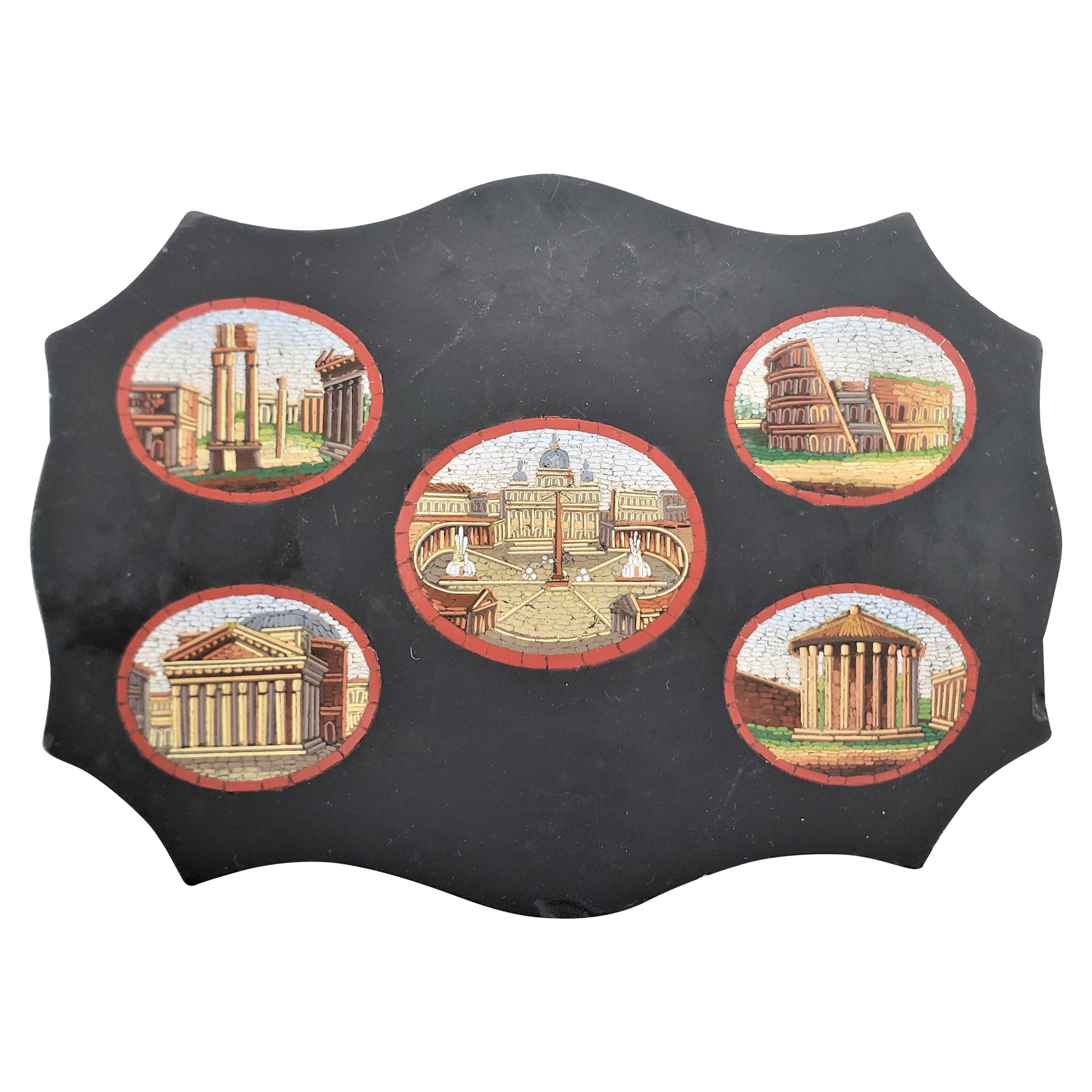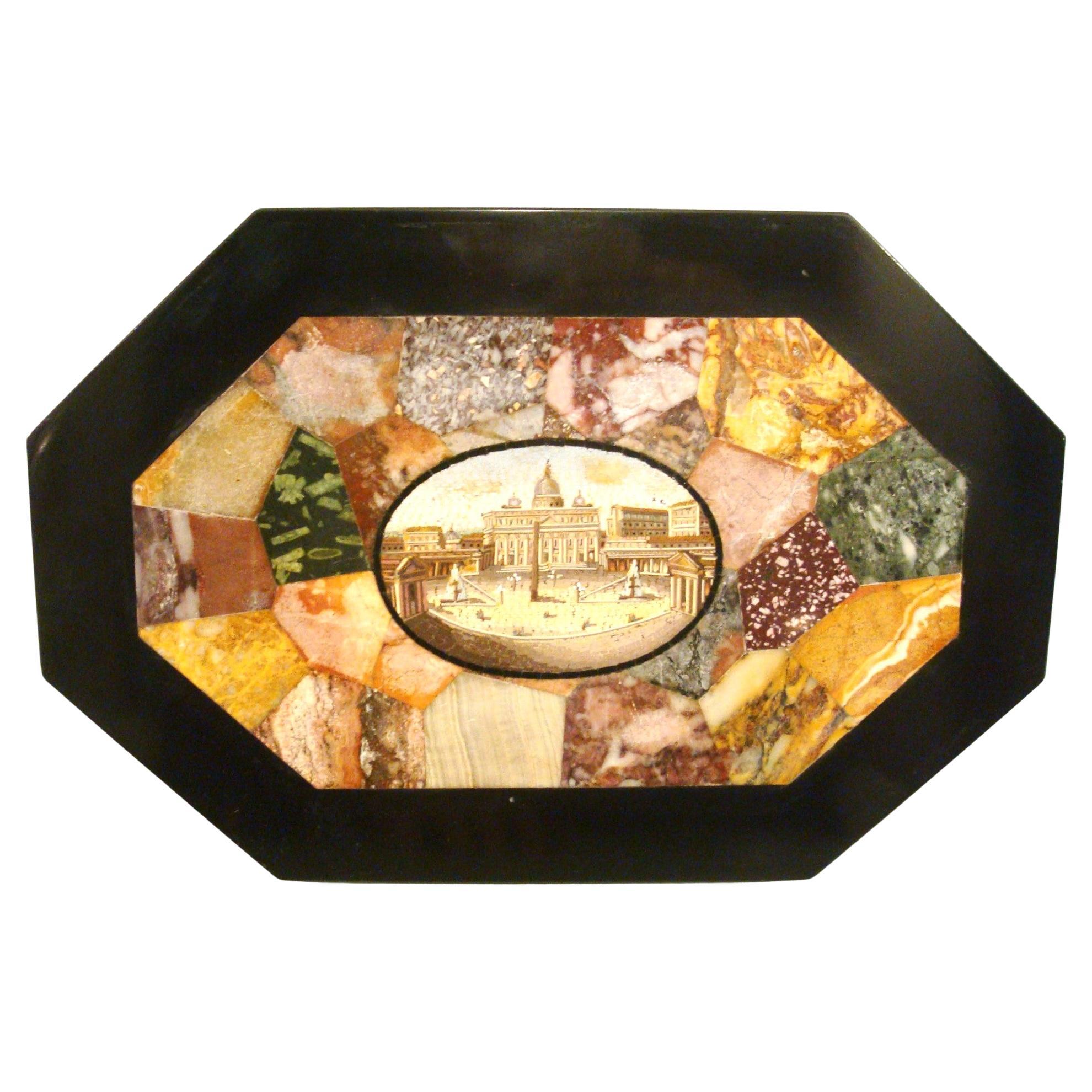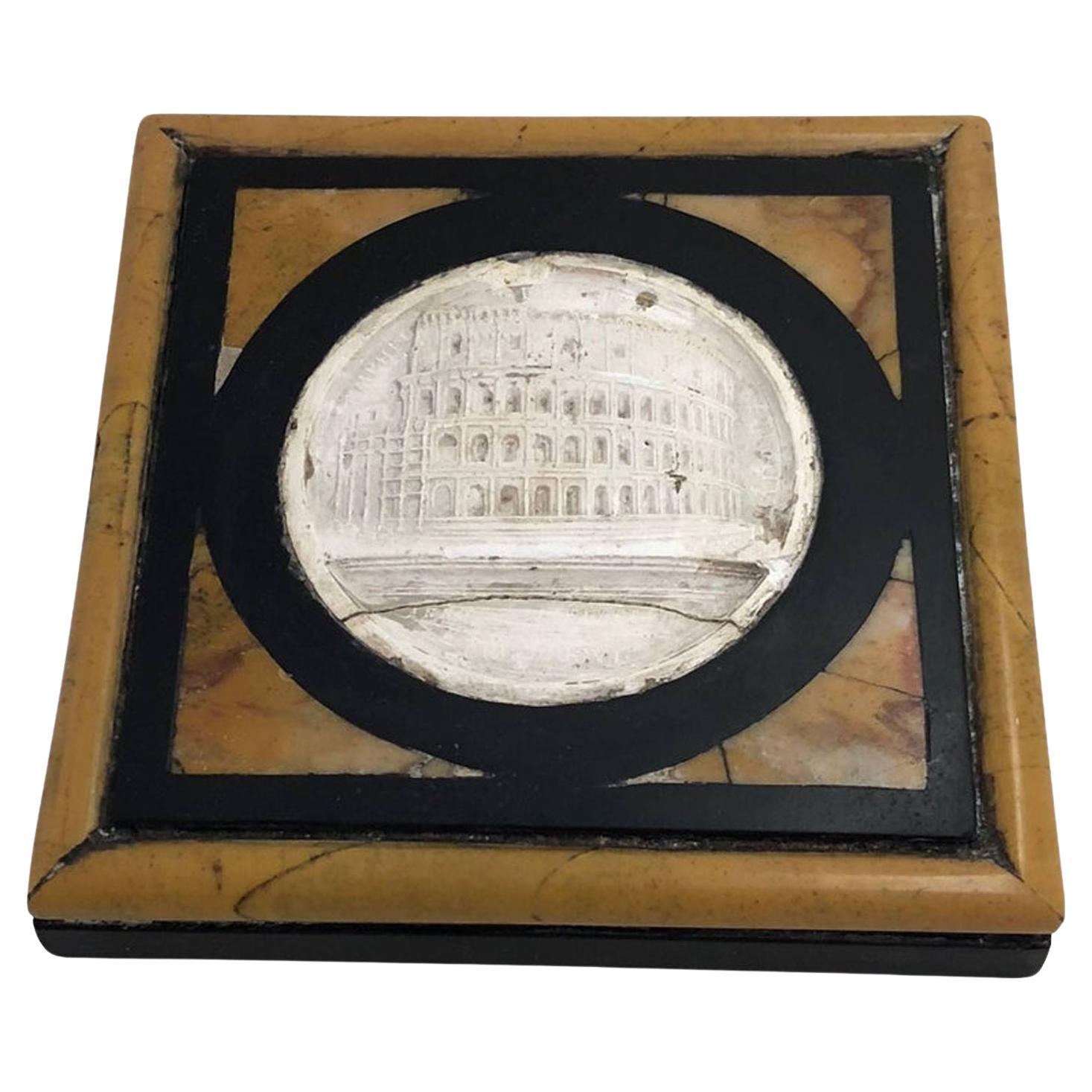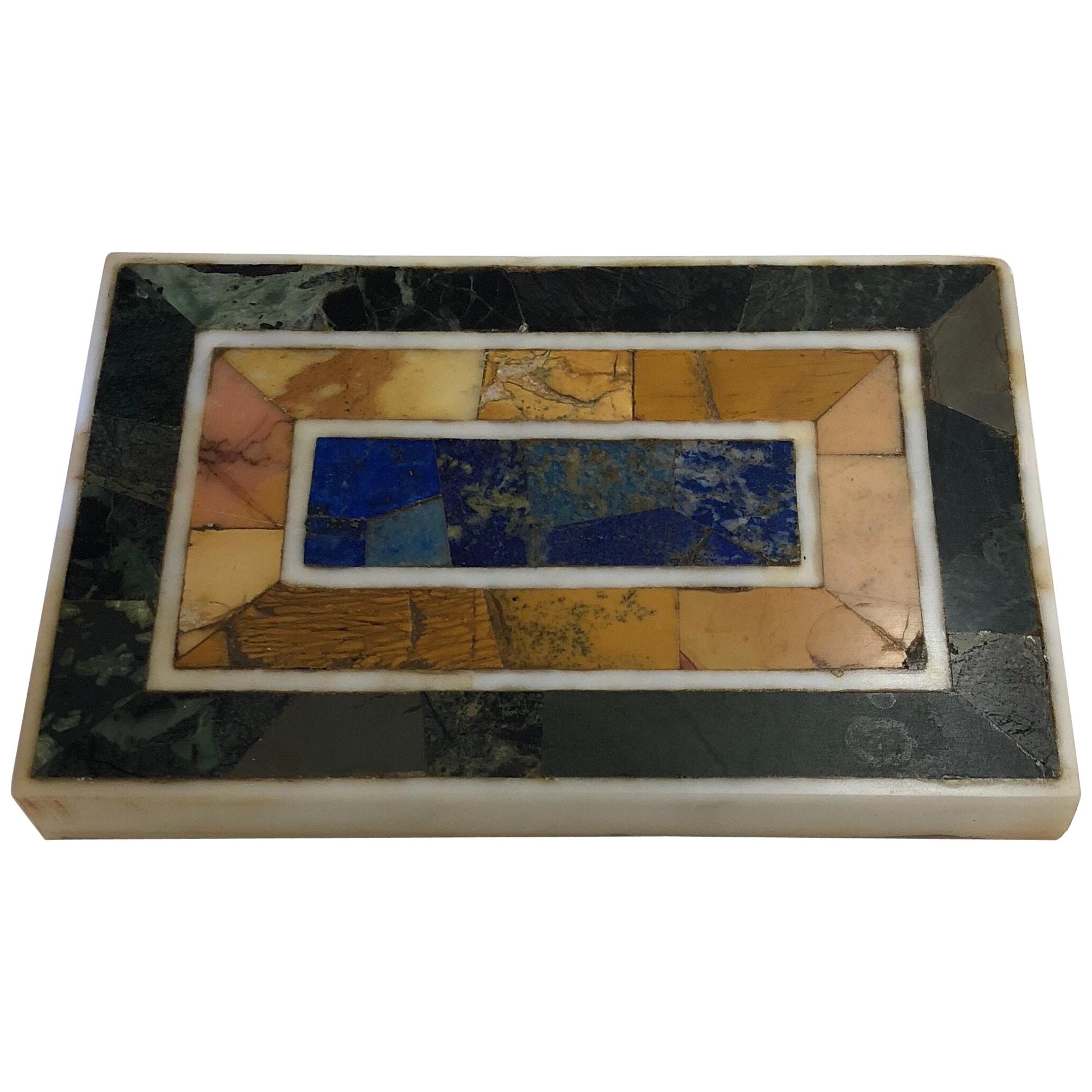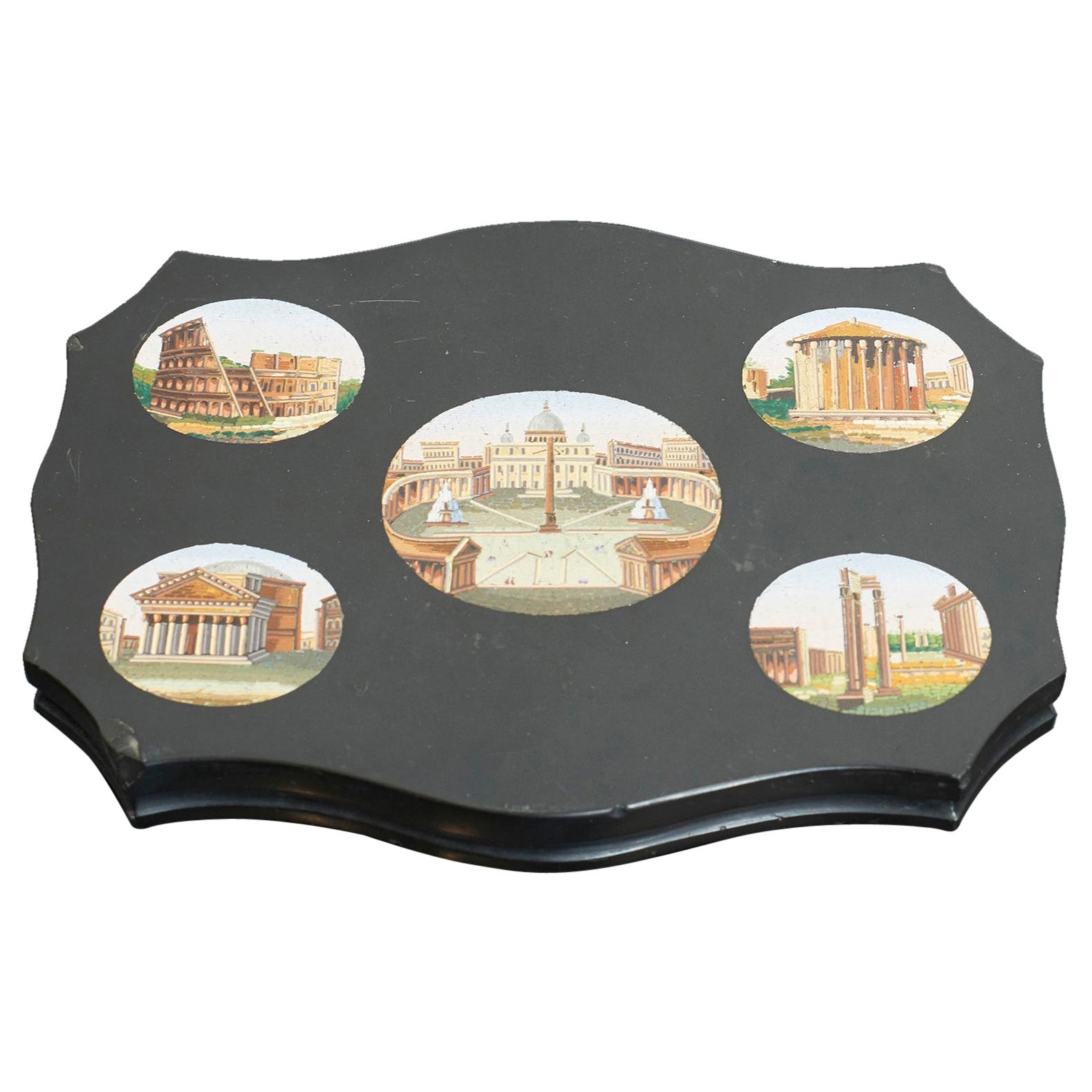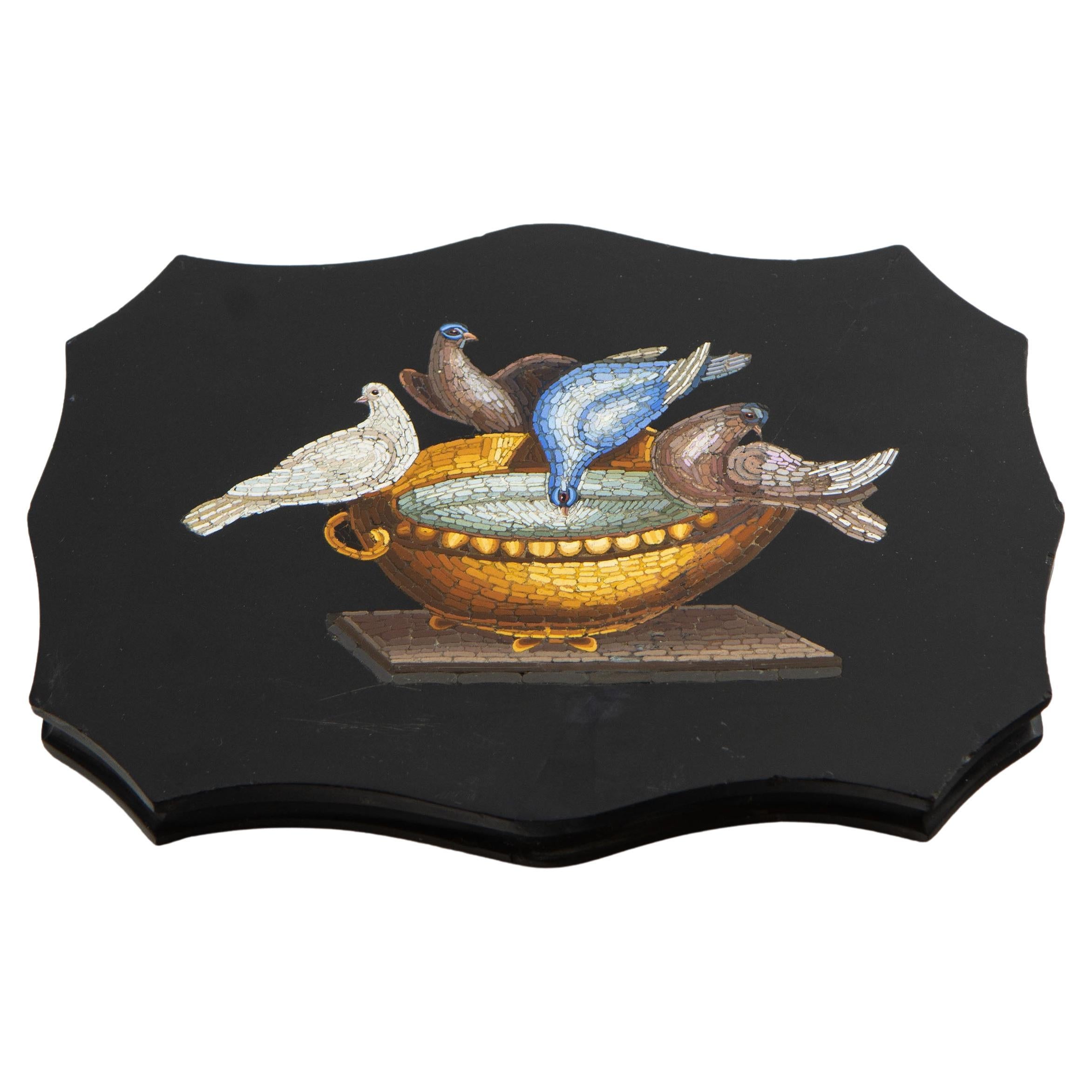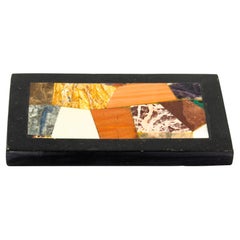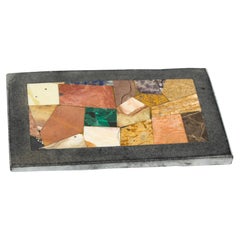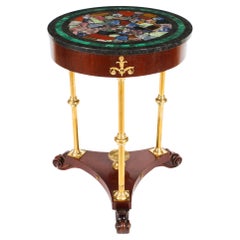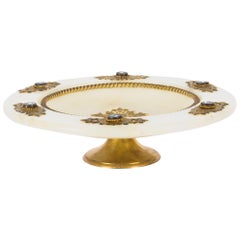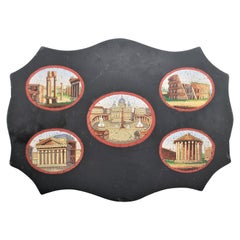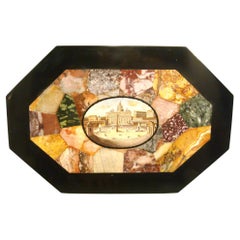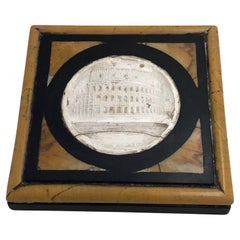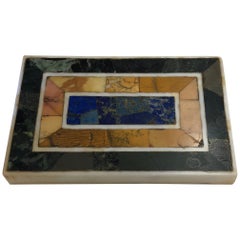Items Similar to Antique Grand Tour Italian Vatican Micro-Mosaic Marble Desk Weight 19th Century
Want more images or videos?
Request additional images or videos from the seller
1 of 20
Antique Grand Tour Italian Vatican Micro-Mosaic Marble Desk Weight 19th Century
$4,524.81
£3,300
€3,848.72
CA$6,196.01
A$6,889.12
CHF 3,597.12
MX$83,857.36
NOK 45,897.66
SEK 43,003.91
DKK 28,723.71
Shipping
Retrieving quote...The 1stDibs Promise:
Authenticity Guarantee,
Money-Back Guarantee,
24-Hour Cancellation
About the Item
This is a stunning decorative antique Italian Grand Tour Vatican Micro-Mosaic inset black marble desk weight, in the form of a miniature table, circa 1870 in date.
The cartouche shaped table top with a central depiction of Saint Peter's Basilica and Piazza, surrounded by views of the Pantheon, the Capitoline, the Temple of Vesta and the ruined Temple of Vespasian, all in oval reserves; raised on a knopped and waisted pedestal, the circular foot exquisitely inset with sample arrangement of semi precious stones including malachite, agate, onyx, cornelian, porphyry and pink granite.
Not only is this desk paperweight very decorative, but it is also an exquisite mineralogical wonder that can be admired by all discerning collectors.
Condition:
In excellent condition, please see photos for confirmation.
Dimensions in cm:
Height 10 x Width 14 x Depth 10
Dimensions in inches:
Height 3.9 x Width 5.5 x Depth 3.9
Micro-Mosaic
From the Renaissance micro-mosaics began to be made in Italy, reaching the height of their popularity in the mid 19th century, when Rome was the centre of production; there was a Vatican Mosaic Studio from 1576, set up to create mosaic replicas of the altarpieces in St Peter's Basilica, which were being damaged by the humid conditions of the vast and crowded interior. They were popular purchases by visitors on the Grand Tour, easily portable, and often taken home to set into an object there. Typical scenes were landscapes of Roman views, rarely of any artistic originality, and the micromosaics were small panels used to inset into furniture or onto snuffboxes and similar objects, or for jewellery.
A distinctive feature of micromosaics is that the tesserae are usually oblong rather than square.[7] The best work can achieve 3,000 to 5,000 tesserae per square inch. The best collections are in the Hermitage Museum and the Gilbert Collection in London.
The Grand Tour was the traditional trip of Europe undertaken by mainly upper-class European young men of means. The custom flourished from about 1660 until the advent of large-scale rail transit in the 1840s, and was associated with a standard itinerary.
It served as an educational rite of passage. Though primarily associated with the British nobility and wealthy landed gentry, similar trips were made by wealthy young men of Protestant Northern European nations on the Continent, and from the second half of the 18th century some South American, U.S., and other overseas youth joined in. The tradition was extended to include more of the middle class after rail and steamship travel made the journey less of a burden.
The primary value of the Grand Tour, it was believed, lay in the exposure both to the cultural legacy of classical antiquity and the Renaissance, and to the aristocratic and fashionably polite society of the European continent. In addition, it provided the only opportunity to view specific works of art, and possibly the only chance to hear certain music. A grand tour could last from several months to several years. It was commonly undertaken in the company of a knowledgeable guide or tutor.
The Grand Tour not only provided a liberal education but allowed those who could afford it the opportunity to buy things otherwise unavailable at home, and it thus increased participants' prestige and standing. Grand Tourists would return with crates of art, books, pictures, sculpture, and items of culture, which would be displayed in libraries, cabinets, gardens, and drawing rooms, as well as the galleries built purposely for their display; The Grand Tour became a symbol of wealth and freedom.
Our reference: A1267
- Dimensions:Height: 3.94 in (10 cm)Width: 5.52 in (14 cm)Depth: 3.94 in (10 cm)
- Materials and Techniques:
- Place of Origin:
- Period:
- Date of Manufacture:circa 1870
- Condition:
- Seller Location:London, GB
- Reference Number:Seller: A12671stDibs: LU950620429282
About the Seller
5.0
Platinum Seller
Premium sellers with a 4.7+ rating and 24-hour response times
Established in 1983
1stDibs seller since 2012
1,374 sales on 1stDibs
Typical response time: <1 hour
Associations
LAPADA - The Association of Arts & Antiques Dealers
- ShippingRetrieving quote...Shipping from: London, United Kingdom
- Return Policy
Authenticity Guarantee
In the unlikely event there’s an issue with an item’s authenticity, contact us within 1 year for a full refund. DetailsMoney-Back Guarantee
If your item is not as described, is damaged in transit, or does not arrive, contact us within 7 days for a full refund. Details24-Hour Cancellation
You have a 24-hour grace period in which to reconsider your purchase, with no questions asked.Vetted Professional Sellers
Our world-class sellers must adhere to strict standards for service and quality, maintaining the integrity of our listings.Price-Match Guarantee
If you find that a seller listed the same item for a lower price elsewhere, we’ll match it.Trusted Global Delivery
Our best-in-class carrier network provides specialized shipping options worldwide, including custom delivery.More From This Seller
View AllAntique Grand Tour Pietra Dura Specimen Top Paperweight, 19th C
Located in London, GB
This is a superb decorative antique Italian Grand Tour marble Pietra Dura mounted desk paperweight, circa 1880 in date.
This splendid rectangular paperweight is exquisitely inlaid with a sumptuous arrangement of semi-precious stones including malachite, agate, onyx and amethyst.
It is beautifully inlaid on a slate base.
Not only is this desk paperweight very functional, but it is also an exquisite mineralogical wonder that can be admired by all discerning collectors.
Condition:
In excellent condition, please see photos for confirmation,
Dimensions in cm:
Height 2 x Width 17 x Depth 10
Dimensions in inches:
Height 1 inch x width 7 inches x depth 4 inches.
Pietra dura is a term for the inlay technique of using cut and fitted, highly polished coloured stones to create images. It is considered a decorative art.
Pietre dure is an Italian plural meaning "hard rocks" or hardstones; the singular pietra dura is also encountered in Italian. In Italian, but not in English, the term embraces all gem engraving and hardstone carving, which is the artistic carving of three-dimensional objects in semi-precious stone, normally from a single piece, for example in Chinese jade.
The traditional convention in English has been to use the singular pietra dura just to denote multi-colored inlay work. However, in recent years there has been a trend to use pietre dure as a term for the same thing, but not for all of the techniques it covers, in Italian.
But the title of a 2008 exhibition at the Metropolitan Museum of Art, New York, Art of the Royal Court: Treasures in Pietre Dure from the Palaces of Europe used the full Italian sense of the term, probably because they thought that it had greater brand recognition. The material on the website speaks of objects such as a vase in lapis lazuli as being examples of "hardstone carving (pietre dure)"
The Victoria & Albert Museum in London uses both versions on its website, but uses pietra dura. "A method of inlaying coloured marbles or semi-precious stones into a stone base, often in geometric or flower patterns...."
Giovanni Montelatici...
Category
Antique 1880s Italian Paperweights
Materials
Agate, Amethyst, Malachite, Onyx, Marble
Antique Grand Tour Pietra Dura Specimen Paperweight 19th C
Located in London, GB
This is a superb decorative antique Italian Grand Tour marble Pietra Dura mounted desk paperweight, circa 1880 in date.
This splendid rectangular paperweight is exquisitely inlai...
Category
Antique 1880s Italian Paperweights
Materials
Agate, Amethyst, Malachite, Onyx, Marble
Antique Italian Pietra Dura Occasional Table, Early 20th Century
Located in London, GB
This is a beautiful antique Italian circular marble top occasional table decorated with ormolu mounts, early 20th century in date.
It is masterfully crafted in walnut and raised ...
Category
Vintage 1910s Italian Side Tables
Materials
Malachite, Marble, Ormolu
Italian Pietra Dura Mounted Brass and Alabaster Comport Dish, 19th Century
Located in London, GB
This is a superb quality antique Italian Pietra Dura mounted, gilt brass and alabaster table-centre comport dish, dating from the late 19th century.
With striking pierced Neo-Gothic chased brass mounts this splendid alabaster dish is set with six highly decorative pietra dura roundels depicting various floral decoration.
It is raised on a sturdy circular brass base.
It is a sumptuous piece which will make a great statement in any special room.
Condition:
In really excellent condition, please see photos for confirmation.
Dimensions in cm:
Height 8 x width 29 x depth 29
Dimensions in inches:
Height 3.1 x width 11.4 x depth 11.4
Pietra Dura is a term for the inlay technique of using cut and fitted, highly polished colored stones to create images. It is considered a decorative art.
Pietre dure is an Italian plural meaning "hard rocks" or hardstones; the singular pietra dura is also encountered in Italian. In Italian, but not in English, the term embraces all gem engraving and hardstone carving, which is the artistic carving of three-dimensional objects in semi-precious stone, normally from a single piece, for example in Chinese jade.
The traditional convention in English has been to use the singular pietra dura just to denote multi-colored inlay work. However, in recent years there has been a trend to use pietre dure as a term for the same thing, but not for all of the techniques it covers, in Italian.
But the title of a 2008 exhibition at the Metropolitan Museum of Art, New York, Art of the Royal Court: Treasures in Pietre Dure from the Palaces of Europe used the full Italian sense of the term, probably because they thought that it had greater brand recognition. The material on the website speaks of objects such as a vase in lapis lazuli as being examples of "hardstone carving (pietre dure)"
The Victoria & Albert Museum in London uses both versions on its website, but uses pietra dura. "A method of inlaying colored marbles or semi-precious stones into a stone base, often in geometric or flower patterns...."
Giovanni Montelatici...
Category
Antique 1890s Italian More Dining and Entertaining
Materials
Alabaster, Brass
Antique French Ormolu Tazza with Limoges Enamel Plaque, 19th Century
Located in London, GB
This is an impressive and highly decorative French ormolu tazza, mid-19th century in date.
It features twin handles to either side and the centre is inset with a beautiful Limoges...
Category
Antique 1850s French Tableware
Materials
Ormolu
Antique French Ormolu & Marble Double Encrier Inkstand Standish 19th Century
Located in London, GB
This is a wonderful antique French Empire Revival ormolu mounted and patinated Verde Antico marble inkstand, Circa 1870 in date.
Of rectangular form with a pair of raised inkwells h...
Category
Antique 1870s English Empire Revival Animal Sculptures
Materials
Ormolu
You May Also Like
Antique Grand Tour Micro-Mosaic Paperweight with Vatican Vignettes
Located in Hamilton, Ontario
This antique Grant Tour micro-mosaic paperweight is unsigned, but presumed to have originated from Italy, or possibly the Vatican City, and dating to approximately 1880 and done in t...
Category
Antique Late 19th Century Italian Victorian Paperweights
Materials
Slate
A Grand Tour Micro Mosaic Paperweight, St. Peter's Square Rome - Vatican
Located in Buenos Aires, Olivos
"Micro Mosaic, St. Peter's Basilica in Rome, XIXth Century"
19th century oval Micro-mosaic depicting a panoramic view of the basilica and St. Peter's Square in Rome (Vatican), enclosed in a shaped slate with inset oval plaque.
Original Italian Micro Mosaic Grand Tour...
Category
Antique 19th Century Italian Grand Tour Paperweights
Materials
Marble
Grand Tour Inlaid Specimen Marble Paperweight, Late 19th Century
Located in Spencertown, NY
The paperweight inset with a plaster cast of the Coliseum, outlined in 'marmo nero' and marmo giallo.
Category
Antique Late 19th Century Italian Paperweights
Materials
Marble
Grand Tour Inlaid Marble Specimen Paperweight, Early 20th Century
Located in Spencertown, NY
The center made up of blue marble veneers, yellow marble and green marble with each section banded by Carrara marble.
Category
Early 20th Century Italian Grand Tour Paperweights
Materials
Marble
19th Century Grand Tour Micro Mosaic Tablet with Roman Views
Located in Kastrup, DK
19th century Micro Mosaic tablet with five oval panels with Roman views, approx. 1860-1880.
Very fine tesserae and small briquettes of semi-precious stone...
Category
Antique 19th Century Italian Grand Tour Wall-mounted Sculptures
Materials
Stone, Marble
19th Century Italian Micro Mosaic Grand Tour Paperweight The Doves Of Pliny
Located in Norwich, GB
19th Century Italian micro mosaic grand tour paperweight - The Doves of Pliny. Rome - Circa 1870.
Cartouche shaped black slate ground, inset ...
Category
Antique 19th Century Italian Grand Tour Paperweights
Materials
Slate
More Ways To Browse
Scale Weights
Scales With Weights
Desk Sculptures
Antique Italian Desks
Desk Marble Top
Marble Top Desk
Antique Weight Scales
Italian Marble Foot
Italian 19th Century Desk
Antique Scale With Weights
Standard Desk Mid Century
Italian Mosaic Jewelry
Grand Tour Collection
Roman Mosaics
Replica Italian
Micro Mosaic Italian
Oval Study Desk
Micro Mosaic Art
